 Farewell Sint-Annaland |
We had intended to depart from Sint-Annaland at 10am to Goes. However, the wind on the water would be a Force 5, and we would be fighting the tide most of the way. Indications were we may be slightly better off starting early, so we slipped our lines at 08:45 and headed out into the Krabbenkreek.
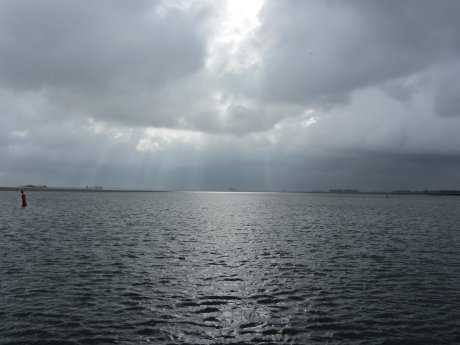 Storm Clouds over Krabbenkreek |
At first all we met were a few barges plying their trade, then along the Mastgat we encountered the odd yacht. Duonita's slamming into the advancing waves was relentless - good for the core muscles.
We had to navigate our way around the mussel farm at the top of the Engelese Vaarwater, bringing our beam onto the galloping waves, resulting in the boat rolling about; a far from delightful experience.
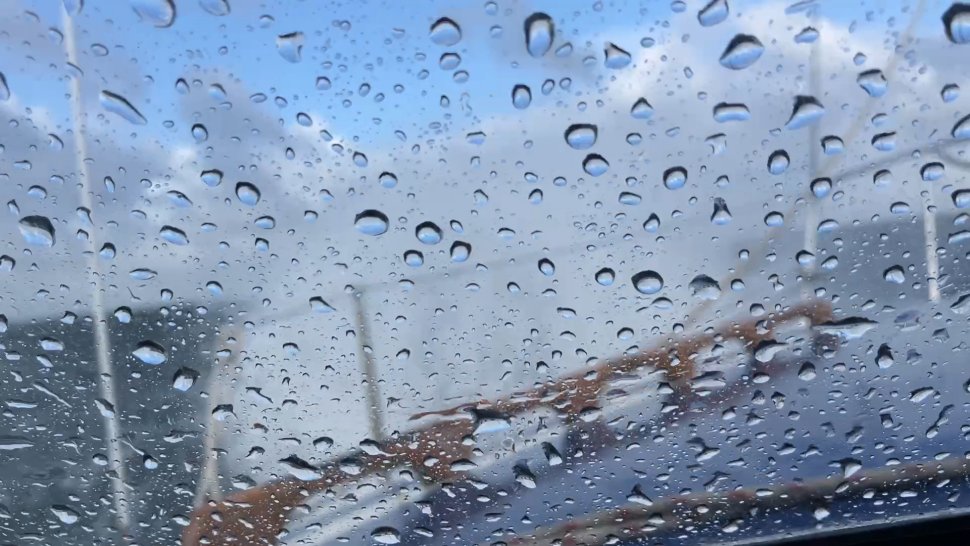 Rough Seas on Keeten-Mastgat |
 De Werf Marina |
Then it was a very pleasant motor down the Havenkanaal, through Wilhelminadorp to Goes itself. After a brief pause at the Ringbrug Goes, we and three other vessels passed through the bridge, where we knew we would find immediately on our left the Goese Watersportvereniging "De Werf". Sure enough, a young fellow was standing on the bank just before the entry into the marina. He was the harbour master. I asked if he had room for us for two nights.
"What is the length of the boat?" he asked.
"8.8m," I replied. He cross checked berths on a sheet on his clip board, and assigned us to Box 25.
Soon we were ensconced in our berth, chatting to the owner of an adjacent boat. The chap lived in Goes, and this was where he kept his craft. His father had helped form the marina in 1952, and sailing had been in his blood from an early age.
The fellow had to get back home, and we needed to stretch our legs after our uncomfortable trip from Sint-Annaland. We headed into town; a town we had visited a few times before in our travels and held fond memories for us.
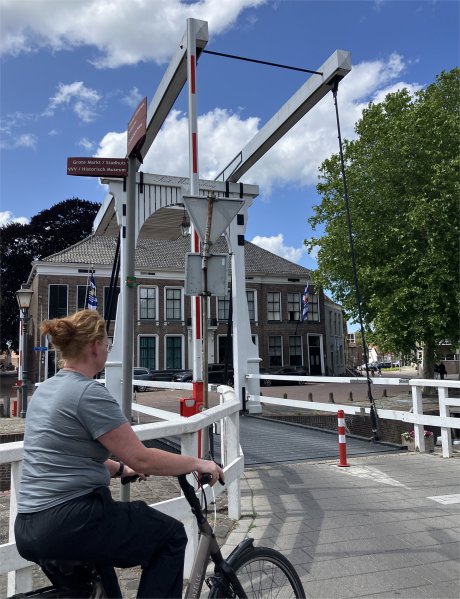 Sint Maartenbrug |
The Eighty Years' War (1568-1648) in the Low Countries was characterised by sieges of cities and forts, field battles being of secondary importance. It was during this period, in autumn 1572, that Dutch forces together with the support of English troops besieged Goes, which at that time was part of the Spanish Netherlands. The siege was relieved in October 1572 by Spanish Tercios (Spanish Third), a Spanish military unit during the period of dominance of Habsburg Spain in Europe and the Renaissance era. The tercio was an infantry formation made up of pikemen, swordsmen and musketeers in a mutually supportive formation, and the Spanish Tercios were the first modern European army, understood as an army of professional volunteers. In 1577, Prince Maurits of Nassau drove out the Spanish soldiers who occupied Goes. He then had built a defence wall around Goes, parts of which were still visible. In the subsequent centuries, Goes maintained its importance as an agricultural centre, but industrialisation never really took off.
We soon reached the pretty Sint Maartenbrug. St. Maarten or Dark Gate stood on the junction of Goeskade and Kleine Kade (Goes and Little Quays) until 1853. Sint Maartenbrug was the only entry/exit point into the Stadshaven Goes. Around 1970 talks took place concerned with the filling in of this basin for a car park. Common-sense prevailed, and instead St. Maartenbrug was erected, allowing water craft to enter the basin for mooring purposes.
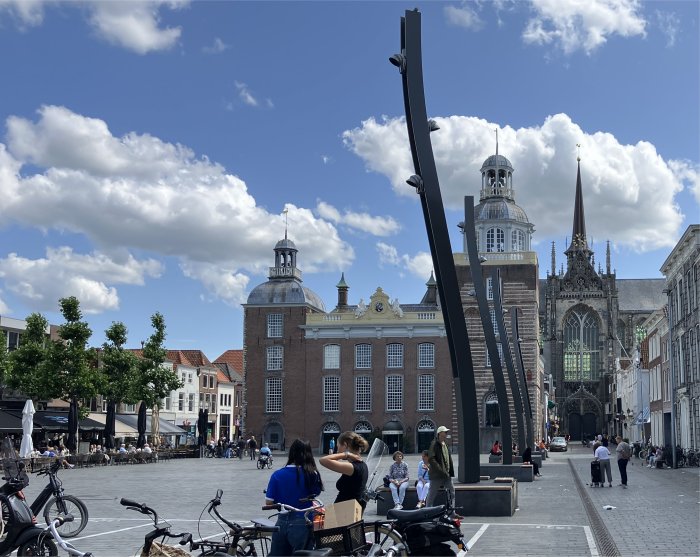 Grote Markt with Stadhuis and Grote Kerk of Maria Magdelenakerk Behind |
The Stadhuis (Town Hall) was late Gothic and Rococo in style. The oldest part was the right tower (1389), which served as a prison, the "vanghuus". In addition, there was a market hall where the weighing-balance stood. Above this stood a hall, furnished like a tribunal where justice was meted out, and where the city council met. Behind the market hall were the meat market and stalls for rent. An orphan room and a city messenger house were built in 1463. The upper floor of the town hall was still used for receptions and weddings.
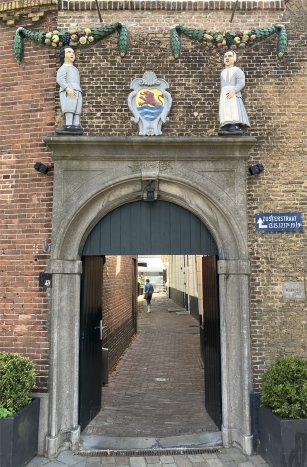 Wesshuis Arch |
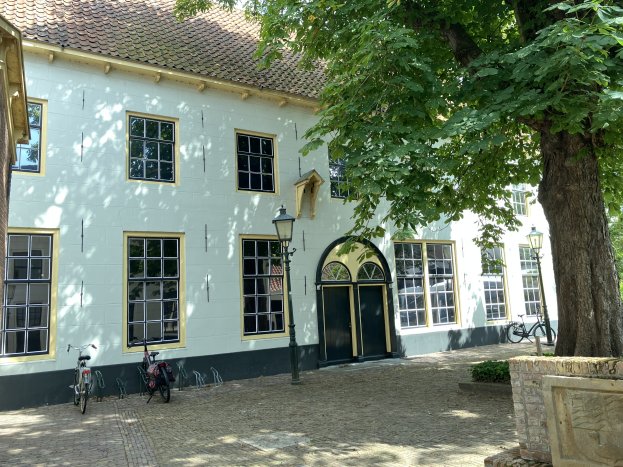 Weeshuisplein |
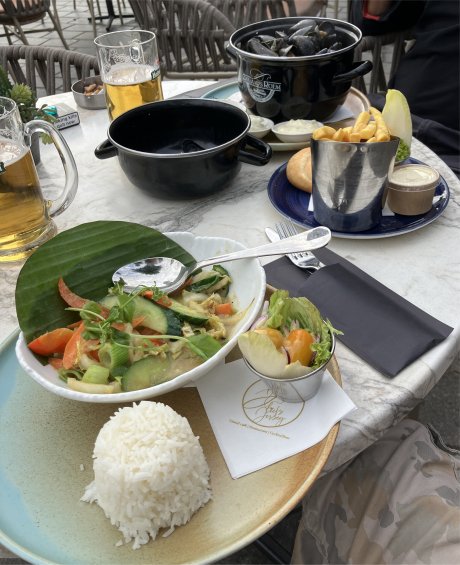 Meal in Grote Markt |
A warren of shoppers' streets lay behind the Grote Markt sending Rex into raptures; he couldn't resist. He dived in whilst I took a walk around the market square. After an age I was worried he was struggling with carrying all his purchases, so I sought him out. I eventually tracked him down - he was assessing shorts. He surpassed himself and bought a pair. Half the town lined up both to admire them and to chase away the moths escaping from his wallet.
In the evening, we returned to the Grote Markt, now a hive of activity as the skeletons of market pitches were being erected. Rex cursed fluently at the swarms of bikes hurtling around the square at breakneck speed. We picked a restaurant at random (most menus were more or less the same), and put the world to rights over a couple of beers. Our food was good.
The evening was starting to chill, so we didn't linger. We headed back to De Werf, passing by the Stadshaven en route. Several British craft were moored here, one of them from Levington. No doubt there was an organised flotilla tour from East Anglia, which is not uncommon.
Peace had descended over the De Werf marina. A few boats had people gathered in their cockpits, reading, chattering, playing scrabble or whatever. The sun was sinking, the wind had dropped and peace reigned (ignoring of course the imminent NATO conference in the Netherlands).
 Stadshaven |
